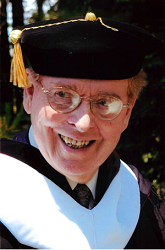
Charles Fillmore
Professor of Linguistics, Emeritus
Born in St. Paul, Minnesota on August 9, 1929, Charles J. (Chuck) Fillmore was to become one of the world’s foremost linguists. His career spanned more than half a century, during which he contributed a constant stream of original and influential ideas. He died in San Francisco on February 13, 2014.
In 1963, Fillmore published a paper that introduced the notion of cylic application of grammatical rules: apply all rules to the smallest applicable unit, then apply them to the smallest unit containing that one, and so on. This principle is still active in grammatical theory.
In 1968, he published the classic paper “The case for case,” which (along with the contemporaneous work of Jeffrey Gruber) introduced into linguistics the issue of the extent to which syntactic structure can be predicted from semantic role classes (called by Fillmore “deep cases”), such as agent, patient, experiencer, goal, location, and a small number of others. Case grammar became a cottage industry and the seminal idea of a hierarchy of what are now called thematic roles acting to determine grammatical relations (subject, direct object, etc.) is still debated among students of grammatical theory.
Fillmore’s influential Santa Cruz Lectures on Deixis, delivered in 1971 (and published in 1975) were a major stimulant to the then nascent field of linguistic pragmatics (concerned with the interaction between linguistic form and the context of utterance), which now flourishes.
In a series of papers spanning ten years, starting in 1975 with “An Alternative to Checklist Theories of Meaning” and concluding in 1985 with “Frames and the Semantics of Understanding,” Fillmore developed the theory that linguistic meaning is better considered from the point of view of the concepts present in the mind of the speaker and aroused in the mind of the addressee than from the dominant view based on the logical formulation of truth conditions. Fillmore’s frame semantics remains one of the principal foundations of the field of Cognitive Linguistics.
In 1988, with colleagues and students at Berkeley, Fillmore introduced another highly influential idea into the study of language. This was to resurrect the notion of grammatical construction from traditional (pre-generative) grammar in an explicit theory, using contemporary, constraint-based formalisms originally developed in computer science and natural language processing. Construction Grammar is now a set of diverse schools, and the need to deal with the kinds of detailed and hard-to-summarize linguistic facts that Fillmore’s constructionist approach pointed to has had influence on syntacticians and semanticists beyond those who term their work “Construction Grammar.”
In his last two decades, Fillmore devoted most of his efforts to the development of an ambitious project of computational lexicography, called FrameNet. This project seeks to build an online lexicon by starting from the conceptual frames that bind together groups of words. Fillmore’s original example was the Commercial Event frame, in which a buyer buys goods from a seller, who sells them, charging some money, constituting the price, which is paid, and which is also what the goods cost and therefore what the buyer must spend. The point is that the italicized words must be understood as a group; they inter-define each other within the frame (or scenario) of the Commercial Event. FrameNet builds online dictionaries arranged by frames. At the time of writing there are significant FrameNet projects going on in Mandarin Chinese, English, German, Japanese, Spanish, Brazilian Portuguese, and French.
Fillmore was an undergraduate at the University of Minnesota. He served in the U.S. Army in the post WWII occupation of Japan, first translating Russian radio messages and, after obtaining an unusual discharge “in theatre,” staying on to teach English. Fillmore returned to the U.S. in 1951. After attending the annual Linguistic Society of America (LSA) Institute at UC Berkeley, he enrolled for graduate study at the University of Michigan, and receiving his Ph.D. in 1961. He taught for ten years at The Ohio State University before joining the Berkeley faculty in 1971. Among other honorable and service titles Fillmore held are The LSA honorary Professorship at the 1979 annual Institute in Salzburg, Germany, Chair of the Berkeley Linguistics Department (1981-1985), Director of the U.C. Berkeley Institute of Cognitive Studies (1986-1991), President of the LSA (1991), recipient of an honorary doctorate from the University of Chicago (2000), co-recipient (with Collin Baker) of the 2012 Antonio Zampolli Prize, and recipient of the 2012 Lifetime Achievement Award of the Association for Computational Linguistics (ACL). In 1994 the annual meeting of the Berkeley Linguistics Society was dedicated to Fillmore’s work (Proceedings of the 20th Meeting of the Berkeley Linguistics Society); in 1995 he was presented with the Festschrift Essays in Semantics and Pragmatics: in honor of Charles J. Fillmore; in 2009 a conference on Frames and Constructions was held in his honor at the annual Meeting of the Berkeley Linguistic Society. The 2014 ACL meeting featured a special workshop, Frame Semantics in Natural Language Processing, also in honor of Fillmore.
Charles J. Fillmore became emeritus in 1995 and received the Berkeley Citation in 1998. Over four decades at Berkeley (including emeritus service), he directed an estimated 40 doctoral dissertations, probably more than any Berkeley linguist past or present. The magnitude of Fillmore’s contributions to the field of linguistics can hardly be exaggerated. “Chuck,” to generations of Berkeley students, colleagues, and friends, remains a figure greatly admired and equally beloved.
Written by Professor Emeritus Paul Kay
Photograph by Late Professor Emeritus John Ohala
2021
